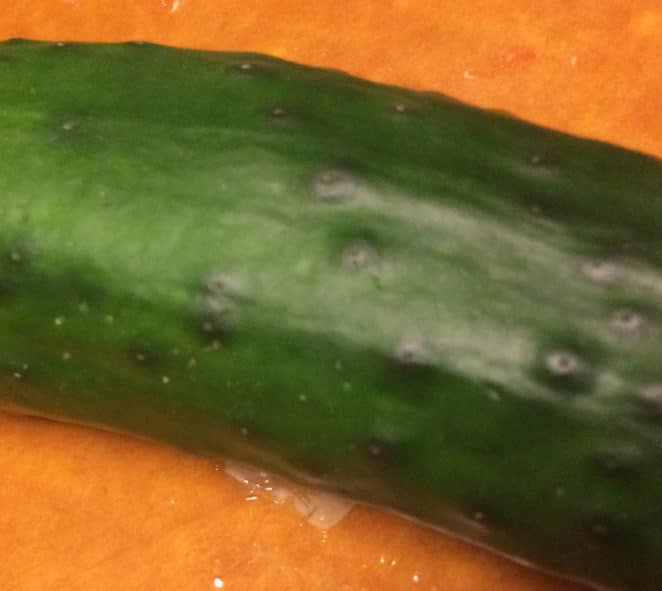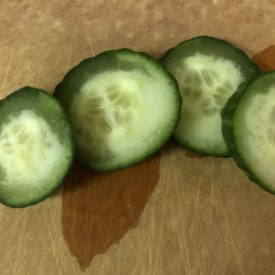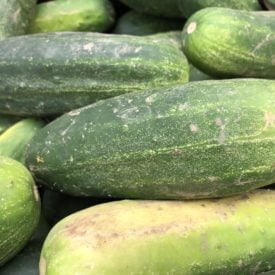Have you ever wondered why cucumbers have those distinctive bumps on their skin? It’s a mystery that has puzzled many curious gardeners and food enthusiasts alike. These bumps, also known as “nubs,” are not just arbitrary features, but they serve a purpose. In this article, we will unravel the mystery of cucumber bumps and explore their significance in the world of cucumbers.

The History of Cucumbers
Origins of Cucumbers
Cucumbers have a long and fascinating history that dates back thousands of years. They are believed to have originated in India, where they were cultivated as early as 3,000 BC. From there, they spread to ancient civilizations in Egypt, Mesopotamia, and Greece. In fact, cucumbers were highly prized by the Greeks and were even mentioned in various historical texts. The Romans also embraced cucumbers, appreciating their refreshing taste and cooling properties.
Cucumber Cultivation
Over time, cucumber cultivation techniques evolved, and different varieties of cucumbers were developed for specific purposes. In medieval Europe, cucumbers were grown in monastic gardens and were primarily used for medicinal purposes. However, it was not until the 16th century that cucumbers became a staple food crop. European explorers brought cucumbers to the Americas, and they soon became popular in North America as well.
Types of Cucumbers
Today, there are numerous types of cucumbers cultivated worldwide. The most common types are slicing cucumbers, which are typically eaten fresh, and pickling cucumbers, which are used for making pickles. Other varieties include English cucumbers, which are longer and thinner, and greenhouse cucumbers, which are grown in controlled environments. Each type of cucumber has its own unique characteristics and uses.
Cucumber Anatomy
External Features
Cucumbers have a distinct appearance with several external features. The cucumber itself is elongated and cylindrical in shape, with a smooth and usually green skin. The skin may also have small bumps or ridges, which vary in prominence depending on the variety. The cucumber is attached to the plant by a stem, and at the opposite end, there is a rounded base called the blossom end. It is important to note that the presence of bumps on the cucumber’s skin is not uncommon and can vary in size and distribution.
Internal Structures
Cutting open a cucumber reveals its internal structures. The flesh of the cucumber is crisp and watery with a pale green or white color, depending on the variety. It is composed of cells filled with water and nutrients, giving the cucumber its refreshing taste. Inside the flesh, there are also seeds, surrounded by a gel-like substance. The seeds are responsible for the reproduction of the cucumber plant, and they can vary in size and number depending on the cucumber variety.

Understanding Cucumber Bumps
What Are Cucumber Bumps?
Cucumber bumps, also known as tubercles, are the small protrusions found on the skin of some cucumbers. These bumps can range from barely noticeable to more prominent, and they can be scattered across the cucumber or concentrated in certain areas. While the presence of bumps on cucumbers might raise questions among consumers, it is a natural and normal characteristic of certain cucumber varieties.
Variability in Cucumber Bumps
The extent and appearance of cucumber bumps can vary significantly depending on the cucumber variety and growing conditions. Some cucumber varieties are specifically bred to have smoother skin with fewer or less pronounced bumps. On the other hand, certain heirloom or specialty varieties may have more textured and bumpy skin. Additionally, factors such as environmental conditions, genetic traits, and cultural practices can influence the development of cucumber bumps.
Factors Influencing Cucumber Bumps
Both genetic factors and environmental conditions can play a role in the formation of cucumber bumps. Genetic traits inherited from the parent plants can determine the presence and level of bumpiness in cucumbers. Environmental factors such as temperature, humidity, and growing conditions can also impact the appearance of bumps. Furthermore, the use of pesticides and chemicals during cultivation may affect the texture and appearance of the cucumber’s skin.
Genetic Factors
Genetic Traits
The presence of bumps on cucumbers is determined by specific genetic traits. Plant breeders can select and breed cucumbers that have smoother skin without bumps through selective breeding. However, certain cucumber varieties naturally possess genes that result in more textured or bumpy skin. By understanding and manipulating these genetic traits, breeders can develop cucumber varieties with different levels of bumpiness and texture.
Inheritance Patterns
The inheritance of cucumber bumps follows specific patterns. Some cucumber varieties exhibit dominant traits for bumpiness, meaning that if one parent possesses the trait, it is likely to be passed on to the offspring. Other varieties may have recessive traits, where both parents need to possess the trait for the bumps to be expressed in the offspring. Understanding the inheritance patterns helps plant breeders in their efforts to develop cucumber varieties with specific physical characteristics.
Role of Mutations
Mutations can also lead to variations in cucumber bumps. These random genetic changes can occur naturally or can be induced by plant breeders. Sometimes, a spontaneous mutation may result in a cucumber variety with more or fewer bumps than its parent plants. If these variations are desirable, breeders can select and cultivate these mutated cucumbers to establish new cultivars with unique characteristics.

Environmental Factors
Temperature and Humidity
Temperature and humidity levels have a significant impact on cucumber growth and development, including the formation of bumps. Cucumbers generally thrive in warm and humid environments. High temperatures and low humidity may result in stressful conditions, which can affect the cucumber’s skin texture and the appearance of bumps. Optimal temperature and humidity levels should be maintained throughout the cucumber’s growth stages to promote healthy development.
Growing Conditions
Well-maintained growing conditions contribute to the overall health of cucumber plants and can influence the texture of the cucumber’s skin. Adequate sunlight exposure, proper irrigation, and appropriate nutrient levels in the soil are essential for optimal cucumber development. Any imbalances or deficiencies in these factors may affect the cucumber’s skin texture and contribute to the formation of bumps.
Pesticides and Chemicals
The use of pesticides and chemicals in cucumber cultivation can have unintended effects on the cucumber’s skin. Some pesticides or chemicals may alter the plant’s metabolism, which can indirectly impact the appearance of bumps on the cucumber’s skin. Additionally, excessive exposure to certain chemicals may disrupt the natural development of the cucumber, leading to irregularities in the skin texture.
Effects of Nutrition
Nutritional Imbalances
Cucumbers, like all plants, require a balanced intake of nutrients to grow and develop properly. Imbalances in nutrient levels can affect the overall health of cucumber plants and may manifest in the texture of the cucumber’s skin. For example, nutrient deficiencies or excesses can cause irregularities in the cucumber’s skin and contribute to the formation of bumps. Providing appropriate and balanced nutrition is crucial for cultivating cucumbers with desirable physical characteristics.
Fertilizer Usage
The type and amount of fertilizer used can impact the growth and appearance of cucumbers. Fertilizers rich in nitrogen can promote vegetative growth but may also lead to an increase in the number and size of bumps on the cucumber’s skin. On the other hand, using fertilizers with a more balanced nutrient composition can help maintain healthy cucumber development without excessive bump formation. Proper fertilizer usage should be tailored to specific soil conditions and cucumber varieties.
Impact of Soil Composition
The composition of the soil in which cucumbers are grown can influence the cucumber’s skin texture. Soil that is too compacted or lacks sufficient organic matter may hinder root development and nutrient absorption, consequently affecting the cucumber’s growth. Additionally, soil pH levels can impact nutrient availability to the cucumber plant, potentially influencing the development of bumps on the cucumber’s skin. Maintaining optimal soil conditions is crucial for producing cucumbers with desirable characteristics.
Pests and Diseases
Common Cucumber Pests
Cucumber plants are susceptible to various pests that can damage the plant and affect the cucumber’s skin. Common pests include cucumber beetles, aphids, and spider mites. These pests can cause physical damage to the cucumber’s exterior, leading to bumps or scars on the skin. Implementing appropriate pest control measures, such as companion planting or the use of organic pesticides, can help minimize the impact of pests on the cucumber’s appearance.
Cucumber Fungal Infections
Fungal infections can also affect the appearance of cucumbers. Diseases such as powdery mildew or downy mildew can cause discoloration and deformities in the cucumber’s skin. In severe cases, fungal infections may result in the formation of raised bumps or lesions on the cucumber’s surface. Maintaining a well-ventilated growing environment and utilizing fungicides when necessary can help prevent and manage fungal infections in cucumber plants.
Viruses Affecting Cucumbers
Certain viruses can affect cucumber plants and contribute to irregularities in skin texture. Viral diseases such as cucumber mosaic virus or cucumber green mottle mosaic virus can cause mosaic patterns or warty-like growth on the cucumber’s skin. These viruses can be transmitted by aphids or other insects. Proper pest control, crop rotation, and use of disease-resistant cucumber varieties are important for managing viral infections and maintaining the cucumber’s appearance.
Cucumber Breeding and Modifications
Selective Breeding for Bumps
Plant breeders have long utilized selective breeding techniques to develop cucumber varieties with specific physical characteristics, including the level of bumpiness. By selecting parent plants that exhibit desired levels of bumps, breeders can develop new cucumber cultivars with more or fewer bumps. This process requires careful control and observation to ensure the desired traits are consistently passed on to future generations.
Genetically Modified Cucumbers
In recent years, advances in genetic engineering have allowed for the modification of cucumber plants on a genetic level. While genetically modified (GM) cucumbers with altered bump characteristics are not currently commercially available, ongoing research explores the potential for modifying cucumber genes to influence skin texture. However, GM crops remain a topic of discussion and regulation, with considerations for potential environmental and health impacts.
Consumer Preferences
When it comes to cucumber bumps, consumer preferences can vary. Some consumers may prefer cucumbers with smoother skin, while others appreciate the natural texture and bumps. Different culinary uses may also influence consumer choices, as pickling cucumbers may require more prominent bumps for better brine absorption. Ultimately, consumer preferences play a role in guiding the development of new cucumber varieties with specific physical characteristics.

Cultural Beliefs and Superstitions
Symbolism of Cucumber Bumps
Cucumber bumps have held symbolic meanings in various cultures throughout history. In some cultures, the presence of bumps on cucumbers is seen as a sign of fertility and abundance. In others, the bumps are associated with good luck and prosperity. These cultural beliefs and interpretations have shaped the perception of cucumber bumps and have influenced the value placed on certain cucumber varieties.
Folklore and Myths
Cultural folklore and myths often incorporate cucumbers and their bumps as central elements. These stories can vary from tales of mythical creatures hiding in cucumber patches to narratives about the healing properties of cucumbers with specific bump patterns. The folklore surrounding cucumber bumps reflects the significance of cucumbers in different cultures and the imaginative narratives that have developed around them.
Cultural Practices
Certain cultural practices surrounding cucumbers and their bumps have been passed down through generations. For example, in some cultures, cucumbers with specific bump patterns are believed to have enhanced flavor or medicinal properties. These beliefs have influenced the cultivation and consumption habits of different communities, further emphasizing the cultural significance attached to cucumber bumps.
Practical Tips for Cucumber Growers
Avoiding Excessive Bumps
Cucumber growers can take several steps to minimize the formation of excessive bumps on cucumbers. Choosing cucumber varieties that naturally have smoother skin can help reduce the presence of bumps. Maintaining optimal growing conditions, including temperature, humidity, and nutrient levels, can also promote healthy cucumber development. Regular monitoring for pests and diseases and implementing appropriate pest control measures is crucial for preventing physical damage to the cucumber’s skin.
Optimal Growing Conditions
Providing cucumbers with optimal growing conditions is essential for healthy plant development and desired skin texture. Ensuring an appropriate balance of sunlight, irrigation, and nutrients in the soil promotes robust cucumber growth. Regularly monitoring and adjusting these environmental factors can help prevent stress on the plants and contribute to the development of cucumbers with desirable characteristics.
Pest and Disease Prevention
Implementing effective pest and disease prevention strategies is vital for maintaining the skin quality of cucumbers. Companion planting, which involves growing complementary plants alongside cucumbers, can help deter pests and reduce the risk of infestations. Physical barriers, such as netting or row covers, can provide additional protection against pests. Furthermore, practicing crop rotation and choosing disease-resistant cucumber varieties can help minimize the risk of fungal infections and viral diseases.
In conclusion, the presence of bumps on cucumbers is natural and can vary depending on genetic factors, environmental conditions, and cultural beliefs. Understanding the origins, anatomy, and factors influencing cucumber bumps provides valuable insights for both consumers and cucumber growers. By employing appropriate cultivation techniques, managing pests and diseases, and considering consumer preferences, cucumber growers can produce cucumbers with desirable characteristics while appreciating the intriguing history and cultural significance associated with cucumber bumps.



